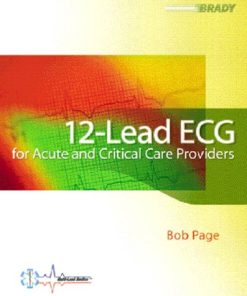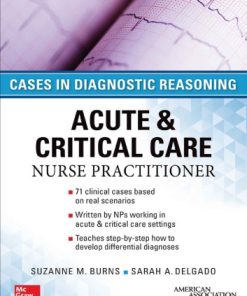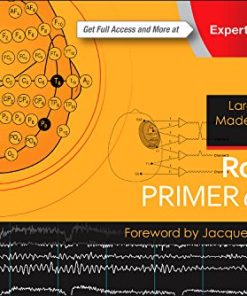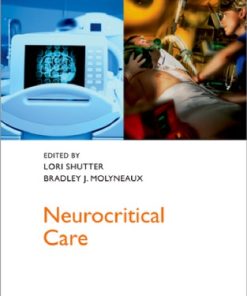(Ebook PDF) Critical Care EEG Basics Rapid Bedside EEG Reading for Acute Care Providers 1st edition by Neville Jadeja, Kyle Rossi 1009261177 9781009261173 full chapters
$50.00 Original price was: $50.00.$25.00Current price is: $25.00.
Critical Care EEG Basics Rapid Bedside EEG Reading for Acute Care Providers 1st edition by Neville Jadeja, Kyle Rossi – Ebook PDF Instant Download/DeliveryISBN: 1009261177, 9781009261173
Full download Critical Care EEG Basics Rapid Bedside EEG Reading for Acute Care Providers 1st edition after payment
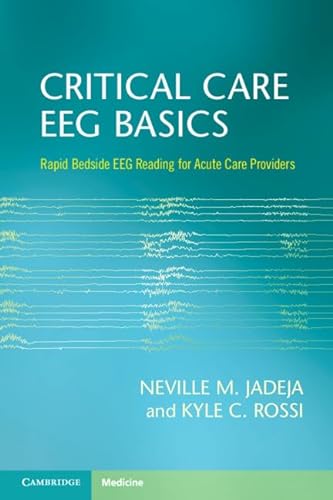
Product details:
ISBN-10 : 1009261177
ISBN-13 : 9781009261173
Author: Neville Jadeja, Kyle Rossi
Easy to read and well-illustrated, this unique guidebook is written for acute care providers of all backgrounds and skill levels, who may be unfamiliar with basic EEG concepts and dependent on reading EEG reports or remote interpretations. This guide introduces the basics of critical care EEG with an emphasis on the skill of real-time bedside EEG reading (pattern recognition). It is presented in two parts using case-based approaches and is full of clinical tips. Readers will become familiar with common critical care EEG patterns, their significance, and management with relevant reasoning. They will also learn how to make basic bedside EEG interpretations to supplement their clinical neurological exam and better collaborate with EEG readers. A dedicated chapter on quantitative EEG explains this important modality. In short, this book enables the use of critical care EEG as a powerful extension to the clinical assessment of critically ill patients.
Critical Care EEG Basics Rapid Bedside EEG Reading for Acute Care Providers 1st Table of contents:
Part I Introduction
Chapter 1 EEG Basics
How EEGs Are Recorded
Three Rules of Polarity
Parts of an EEG Machine
Electrodes
Application of Electrodes
Placement of Electrodes
Montages and Localization
Montages
Localization
Display (Parameters)
Frequency
Rhythm
Normal Adult EEG
Awake
Drowsy
Sleep
Strengths and Limitations of EEG
Strengths
Limitations
References
Chapter 2 Indications
When to Request an EEG
Acute Brain Injuries (e.g., Trauma, Hemorrhage, Ischemia, and Encephalitis)
Altered Mental Status (without Acute Brain Injury)
After Convulsive Status Epilepticus (CSE) or Generalized Tonic Clonic (GTC) Seizures without Return to Baseline
Management of Refractory Status Epilepticus (RSE)
Monitoring Depth of Anesthesia/Sedation
Paroxysmal Clinical Events Concerning for Seizure
Pharmacological Paralysis
Post Cardiac Arrest (CA)
Brain Death (Death by Neurological Criteria)
Limitations of Critical Care EEG
Continuous vs. Routine EEG
Making the Correct Choice
Duration of Monitoring
Advantages of Bedside EEG Reading
Advantages – Why Read This Book?
Limitations
References
Chapter 3 Real-Time Bedside EEG Reading
What to Know Before You Begin Reading
Three Easy Steps for Bedside EEG Reading
Step 1: Analyze the Background
Step 2: Search for Abnormal Waveforms, If Any
Step 3: Recognize Artifacts
How to Analyze the Background
What Is Continuity?
What Is Symmetry?
What Is Voltage?
What Is the Predominant Frequency?
Abnormal Waves
Morphology
Location
Occurrence
How to Check for Reactivity
Clinical Significance of EEG-R
Qualitative Grading of Encephalopathy
References
Chapter 4 Recognizing Artifacts and Medication Effects
What Are Artifacts?
Internal Artifacts
Ocular (Eye) Artifacts
Glossokinetic (Tongue) Artifact
Cardiac Artifacts
Myogenic Artifact (EMG)
Skin (Sweat) Artifact
External Artifacts
Electrode Artifact
Ventilator Artifact
Suctioning
Bed Percussion
Chest Compressions and Sternal Rubs
External Medical Devices
Common Medication Effects
EEG Patterns with Intravenous Anesthesia
EEG Patterns with Inhalational Anesthesia
References
Chapter 5 Epileptiform Discharges, Seizures, and Status Epilepticus
Define Epileptiform Discharge
Define Seizure
Define Status Epilepticus
Electrographic Criteria for Seizures
Electrographic Criteria for Status Epilepticus
Brief Potentially Ictal Rhythmic Discharges (BIRDs)
Refractory Status Epilepticus
Super-Refractory Status Epilepticus
References
Chapter 6 Rhythmic and Periodic Patterns (RPPs) and the Ictal‐Interictal Continuum (IIC)
Standardized EEG Terminology for RPPs
Common Types of RPPs
Common Causes of RPPs
Differentiate Distinct Ictal Patterns from Interictal Patterns
Markers of Higher Risk and Pathogenesis
Ictal‐Interictal Continuum (IIC)
Management of RPP and IIC Patterns
References
Chapter 7 Post–Cardiac Arrest EEG
Continuous EEG Monitoring preposition Cardiac Arrest
Hypothermia Protocols
Continuous EEG Use in Neurological Prognostication
Standardized EEG Interpretation Can Aid in Predicting Neurological Outcomes
Anoxic Myoclonic Status Epilepticus
Differentiating Anoxic Myoclonic Status Epilepticus from Lance–Adams Syndrome
EEG in Brain Death Protocols
References
Chapter 8 Quantitative EEG (EEG Trend Analysis)
Efficiency of Interpretation
Amplitude Integrated EEG
Description
Applications
FFT Spectrogram
Description
Applications
Rhythmicity Spectrogram
Description
Applications
Asymmetry Indices
Description
Applications
Seizure Detectors
Other Trends
Burst Suppression Ratio
Alpha–Delta Ratio
Enveloped Trend (Peak Envelop)
Limitations and Caveats
References
Part II Introduction
Chapter 9 Nonconvulsive Status Epilepticus (NCSE)
Diagnosis of NCSE
Types of NCSE
Management of NCSE
Refractory SE
How to Titrate to Burst Suppression
Super-Refractory SE (SRSE)
How to Recognize SRSE (Failure to Wean Anesthesia)
How to Recognize SE Cessation (Stop, Stutter, or Slowly Fade Away)
Absence SE
References
Chapter 10 Management of the Ictal‐Interictal Continuum (IIC)
Plus [+] Terms
Evolving Patterns
Ictal‐Interictal Continuum (IIC)
Interictal (Not Ictal) Patterns
Stimulus Induced Patterns
References
Chapter 11 Seizures and Epileptiform Discharges
Seizures
Seizure Burden
Brief Potentially Ictal Rhythmic Discharges (BIRDs)
Sporadic Epileptiform Discharges
Clinical Significance
References
Chapter 12 Seizure Mimics
Tremors
Myoclonus
Syncope
Functional Seizures/Psychogenic Non-Epileptic Seizures (PNES)
References
Chapter 13 Focal Lesions
Focal Cerebral Dysfunction
Breach Effect
Lateralized Rhythmic Delta Activity (LRDA)
Epilepsia Partialis Continua (Kozhevnikov Syndrome)
References
Chapter 14 Encephalopathy
Global Cerebral Dysfunction
Generalized Rhythmic Delta Activity (GRDA)
GPDs with Triphasic Morphology (Triphasic Waves)
Cyclical Alternating Pattern of Encephalopathy (CAPE)
References
Chapter 15 Coma
Extreme Delta Brush (EDB)
Alpha-Coma and Other Variants
Electrocerebral Inactivity (ECI)
People also search for Critical Care EEG Basics Rapid Bedside EEG Reading for Acute Care Providers 1st:
how long can you sleep before an eeg
what is a good eeg reading
how to read eeg basics
critical care eeg terminology
critical care eeg guidelines
Tags:
Critical,Care EEG,Basics Rapid,Bedside EEG,Acute Care Providers,Neville Jadeja, Kyle Rossi
You may also like…
Medicine - Neuroscience
MEG EEG Primer 2nd Edition by Riitta Hari, Aina Puce 0197542190 9780197542194
Medicine - Neurology
Medicine - Neurology
Neuroscience for Neurosurgeons 1st Edition by Farhana Akter 1108918468 9781108918466





